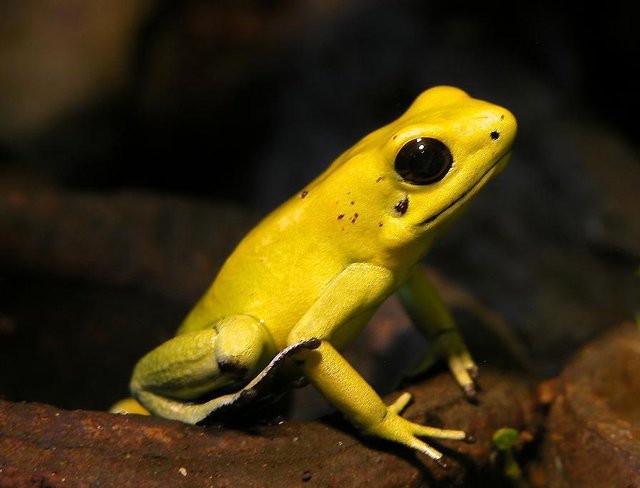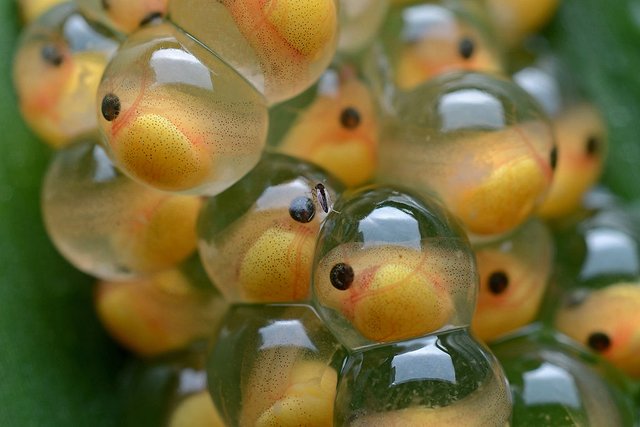Poisonous Creatures #3 - Golden Dart Frog
Introduction
Hello Steemians and friends, it's been a while I published a STEM article, and that's due to the fact, that I was ill. I'm glad to be back. Those who have followed my previous editions of venomous creatures would be wondering why I changed the title to poisonous creatures. The reason is that I'm going to be talking about a poisonous creature today. I know some of you would be wondering, isn't venomous creatures same as poisonous creature? The answer is NO. The difference between venomous creatures and poisonous creatures, is that, venomous creatures inject their venom into their preys by biting it into them, while poisonous creatures release their poison into their predators when their predators touch, lick or eat them.
Alright, enough with that. Today we are going to be looking at the Golden Dart Frog . Frog??, yea frog (smiles). This specie of frog is the most poisonous of all frog species and the most poisonous creatures on earth. Don't be deceived by how beautiful they look, or how small they are or the fact that, they are frogs. These beautiful creatures are very very deadly, I mean just touching them could lead to death.
This article would cover the necessary details you need to know about the Golden Dart Frog. I know you can't wait to know about this beautiful but deadly creature. So just relax yourself and get thrilled with this article I made just for you (smiles).

Golden Dart Frog - Phyllobates Terribilis
The Golden Dart Frog is the most poisonous specie of frogs and the most poisonous creature on earth. They are also known as Golden Poison Frog, Golden Frog or Golden Poison Arrow Frog. The name Golden Dart Frog came about due to the fact that they were used by the native Colombians to poison their blow gun darts. They got the poison from these frogs by heating them over a fire. The heat from the fire made them agitated and then they began to bring out the poison from their backs, the native Colombians would then wipe the tips of their darts or arrows over the backs of these frogs to get the poison. The poisoned darts or arrows can remain potent/lethal for up to one year and even more.
These frogs can only be found in the Amazonian rainforest along the Pacific Coast of Colombia. These creatures are uniformly colored unlike the other species of the poison dart frogs, that have dark spots and stripes. The Golden Dart Frogs are colored mint green or orange or white but they are mostly colored, yellow or deep yellow, which is why they are called Golden Dart Frogs. Their bright colors are not used for camouflaging but to warn their predators that, they are very poisonous and it's best they stayed away.
Scientific Classification - Kingdom: Animalia, Phylum: Chordata, Class: Amphibia, Order: Anura, Family: Dendrobatidae, Genus: Phyllobates, Species: P. terribilis, Binomial name: Phyllobates terribilis (Myers, Daly and Malkin, 1978). Source
Other species of Poison Dart Frog are usually shy in nature but the Golden Dart Frog is bold in nature, reason being that, it does not fear it's predators because of the poison it possesses. In their mind, touch, lick, or eat me and die (hahaha). The Golden Dart Frog fears no one except the Fire-Bellied Snakes [Leimadophis Epinephelus]. This special snake is resistant to the toxins secreted by the Golden Dart Frogs and this makes them the only natural predator of the Golden Dart Frogs.
A distinctive feature of the Golden Dart Frog from other species of the poison dart frog is a bony teeth-like plate found in the upper jaw of the Golden Dart Frog. This bony teeth-like plate found in the upper jaw of Golden Dart Frogs makes them look as if they possess teeth. Unlike most frogs that are nocturnal in nature, the Golden Dart Frogs are diurnal in nature i.e they are active during the day.
Just like the deathstalker scorpions, the adult females of the Golden Dart Frogs are usually larger than the males. The average length of the females reaches about 50 - 55 mm, while for the males it's about 47 mm. Golden Dart Frogs are usually less aggressive to the members of their specie compared to the other species of poison dart frogs. These creatures are very sociable, they always live in groups ranging between 4 - 7. But if they are becoming more than 7 in a group, they begin to become a little bit aggressive and would mostly send some out of the group. They are territorial in nature, not allowing any non-member of their group into their territory (funny creatures). They mostly communicate with calls and also with gestures. Whenever they are performing push-ups, it signals dominance and whenever they are lowering their heads, it signals submission. Let's now move on to the way they reproduce..
.jpg)
Reproduction
Golden Dart Frogs are Polygnandrous in nature i.e both males and females Golden Dart Frogs have more than one mating partner during a breeding season. Golden Dart Frogs' process of mating is frantic frenzy in nature i.e very fast and not that much orderly. Breeding normally occurs throughout the raining season.
The male Golden Dart Frog would call for a female with 2 buzzing or trilling calls. The first call normally last for about 6 - 7 seconds and the second call last for about 2 - 3 seconds. The called female and the male would then move to a moist area like under rocks or in a leaf litter where she would lay her eggs ranging between 12 - 20 eggs, which the male would then fertilize. It would take the eggs about 2 weeks for them to hatch. During the 2 weeks period, the male frequently revisit the eggs to keep them moist and to protect them. When the eggs finally get ready to hatch, the male would use his hind legs to free the grey-brown tadpoles. The freed tadpoles would crawl onto the male's back and then the male would carry them and deposit them in a small pool of water and then awaits their metamorphosis i.e their development to becoming froglets. Let's now move on to their feeding habits.
Feeding
As I earlier said, these creatures are diurnal in nature, therefore, they hunt for their food during the day. The Golden Dart Frogs are the most voracious member of the Dendrobatidae family. They are insectivores creatures i.e these are creatures that feeds on insects. They mainly feed on species of Paratrechina and Branchmyrmex ants. They also feeds on invertebrates such as beetles and termites. Studies have shown that these creatures get their toxicity from the insects they feed on, don't worry I will share more light on that later. The Golden Dart Frogs usually stalk their prey and then attack very quickly by using their long sticky tongues to capture their preys. They don't use their poison when attacking their preys unlike venomous creatures that makes use of their venom to subdue their prey. Golden Dart Frog just make use of their long sticky tongues to capture their preys and their poison to defend themselves.
As I earlier said, they fear no creature except the Fire-Bellied Snake [Leimadophis Epinephelus]. These snakes are resistant to the toxins produced by Golden Dart Frogs, but are not immune to the toxins. These snakes are believed to be able to detoxify the Golden Dart Frog's poison with a substance contained in their saliva. Although these snakes doesn't hunt the adult Golden Dart Frogs because the high toxicity they possess, so the adult Golden Dart Frogs fears no creature(smiles).
Life Cycle
Let's begin the life cycle of the Golden Dart Frogs from the point when the eggs are ready to hatch and male frees the grey-brown tadpoles and then carries them to deposit in a small pool of water, where he waits their metamorphosis. It takes about 10 - 14 weeks for grey-brown tadpoles to metamorphose into a miniature adults called Froglets. During this period of metamorphosis, the tadpoles begins to grow hind limbs and they start to exchange their gills with legs. The tadpoles mainly feed on algae and mosquito larvae during this period.
After the period of metamorphosis, the parents would then lead them to the family group during which that period, the froglets begin to resorbs the rest of their tails and continues to grow until they become adults. It takes a froglet an average of 13 months to be sexually matured for reproduction. The life span of a Golden Dart Frog depends on whether it lives in the wild or in captivity. In the wild, the life span of a Golden Dart Frog is 5- 7 years, while in captivity it is 10 - 15 years.

Poison
The Golden Dart Frog is the most poisonous creature in the world. The amount of poison in an adult Golden Dart Frog is capable of killing about 20,000 mice, or 10 - 20 matured humans or 2 matured Africa bull elephant. No creature on earth possess this much poison. Holding this creature with your bare hands i.e without gloves, is like committing suicide.
The Golden Dart Frog's skin is covered in an alkaloid toxin that contains batrachotoxins. The batrachotoxins is one of the most dangerous toxins as it prevents it's victim's nerve from transmitting impulses, which causes paralysis, then heart failure and then death. Each adult Golden Dart Frog carries about 1900 micrograms of batrachotoxins in their skin, making them the most poisonous creature in the world.
How does this creature gets it's toxins? Studies have shown that these creatures gets it toxins due to their consumption of small insects and it is believed that the small beetle from the family Melyridae is the main source of this creature poison. This particular small beetles produces the same toxins that is also found in the Golden Dart Frogs and these small beetles are found in the Amazonian rainforest too. This is why the captive Golden Dart Frogs have no poison, reason being that, they don't consumed insects[small beetles] which are rich in alkaloids, that are found in the wild. The most poisonous creature in the world, is the safest dangerous creature to keep in captivity(smiles).
The Golden Dart Frogs makes use of their poison for the sole purpose of defending themselves and not for killing their preys. These frogs stores it's poison in it's skin glands, thereby killing any predator that touches, licks or even eats it. How come the poison doesn't harm these creatures? It's simple, the alkaloid toxins that covers the skin of these creatures contains batrachotoxin. The batrachotoxin normally attack the sodium channels of the nerve cells of it's victim's. which prevents the nerves from transmitting impulses which would then cause muscle paralysis, and then heart failures and finally death. But the Golden Dart Frogs have a special sodium channels which makes the poison harmless to them.
On the bright side, studies have shown that the poison of a Golden Dart Frog have some potentials to be a far better anesthestic than morphine.
Threats
These beautiful but deadly creatures are likely to become extinct due to the destruction of their natural rainforest habitat through deforestation for agricultural cultivation, illegal gold mining, human development and logging. And therefore, they have been listed as endangered species, according to the IUCN Red List of Threatened Species.
However, some conservation efforts have been put in place to prevent these creatures from becoming extinct. For instance, the Decree INDERENA No. 39 of 9 July 1985 which prohibits the collection of these creatures from the wild in Colombia, and the establishment of the Rana Terribilis Amphibiam Reserve in the rainforest of Colombia by the international conservation charity, World Land Trust. These conservation efforts have to some extent protected this specie and have ensured their continuous existence.
Amazing Facts
- Golden Dart Frog is the most poisonous creature in the world.
- They are diurnal in nature.
- Their only natural predator is the Fire-Bellied Snake.
- They are capable of killing 20,000 mice or 10 -20 adult humans or 2 adult Africa bull elephant.
- Their main source of poison is from small beetles from the Melyridae family.
- The females are usually larger than the males.
- Captive Golden Dart Frogs are not poisonous.
References
I'm a proud member of @air-clinic

I'm a proud member of @promo-mentors

I'm a proud member of @stach

I'm a proud member of @stemng

I'm a proud member of @steemstem

 )
 )
 )
It is great to know of the such an specie. That means a huge physical strength, powerful fangs and razor-sharp teeth are not the only weapon used in the animal kingdom. Thousands of animals use highly toxic poisons for attack or defense. I knew some what about Royal Kobra as a poisonous creatures in the world.
Yea, the venomous creatures are known and scary but the most dangerous to me are poisonous creatures because you just see them as harmless, and boom !!!, dead.
Thanks for coming around @mike11
Hi, @menoski. Nice piece of article. I would like to point out one thing:
Please note that I'm not in any way, try to disapprove your work. You've done an excellent job here, but you can make it better. If you have any problem regarding STEM-related articles, you can join steemSTEM Discord Channel and we will be glad to assist you.
I have checked the grammatical errors and corrected them. Thanks a lot @chloroform
God! I hate frogs now that one of them is the most poisonous creature well well...
Hahaha. You shouldn't hate frogs, you are in Africa you are completely safe. Only countries that are in Central and South America that have poison frogs.
I heard frogs are quite taste, yummy, hahaha
No need to hate frogs from here @joeycrack
I once saw a Nat Geo Wild video, not sure if it was this Dart Frog, but the summary was that the Frog in question got swallowed by a snake. Few minutes the later the snake died, and the Frog walked out of the mouth of the snake unscathed.
But this fellow sounds insanely dangerous
Great read!
hahahaha, it could Golden Dart Frog or any Poison Dart Frogs. These creatures are really dangerous, because they are very deceptive, you see them as harmless. Sorry to that snake(hahaha), next time it couldn't pick out a brightly colored frog to eat.
Thanks for coming around @agbona
We should have more poisonous animals around here. It’ll go a long way in curbing animal endangerment. Thanks for sharing this
Yea, it would really be a difficult curbing these creatures endangerment because these creatures can bring death, imagine a family cooking this frog for a family meal, it would completely wipe out the family and yet it is protected. And also humans are rising in population, we therefore would need to increase our settlement leading to destruction of these creatures habitat. But there is still need to have these creatures around. Imagine there are still dragons kept somewhere, won't that be great.
Thanks for coming around @florae